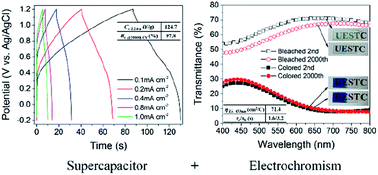Electrochromic and energy storage bifunctional Gd-doped WO3/Ag/WO3 films†
Abstract
In this study, using gadolinium (Gd) as a dopant, Gd-WO3/Ag/Gd-WO3 (WGd–Ag–WGd) transparent conductive films with improved electrochromic (EC) and energy storage performance were fabricated on glass substrates by reactive sputtering. The EC performance and sheet resistance of WGd–Ag–WGd are shown to be sensitive to the concentration of the Gd dopant. The optimized structure for transparent conducting (TC) coating is obtained to be Gd-WO3 (52 nm)/Ag (12 nm)/Gd-WO3 (42 nm) with a luminous transmittance of 82.7% and a sheet resistance of 3.4 Ω sq−1 at a modest Gd doping concentration of 0.29 at%. Such a film (sample size of 1 cm × 3 cm) exhibits luminous transmittance modulation (ΔTlum = 49.6%), high coloration efficiency (71.4 cm2 C−1 at 633 nm), fast switching time (1.6 s for coloring and 3.2 s for bleaching time), and long-term cycling stability (2000 cycles) with an applied potential of ±1.0 V. By combining the film structure characterization and electrochemical analysis, such a decent performance can be attributed to the embedded island structured monoclinic Gd2O3 on the surface of WO3 which enhanced charge capacity and reaction kinetics compared with undoped amorphous WO3 films. Moreover, the WGd–Ag–WGd films showed superior capacitive capability with a maximum specific capacitance of 124.7 F g−1 at 2 A g−1, suggesting their potential application in electrochemical energy storage (ECES) devices.



 Please wait while we load your content...
Please wait while we load your content...